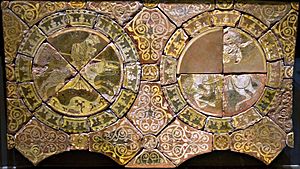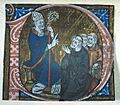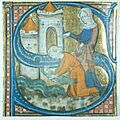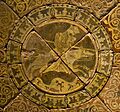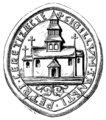Chertsey Abbey facts for kids

Medieval stained glass with the arms of the abbey, a sword and the keys of St Peter
|
|
| Monastery information | |
|---|---|
| Order | Benedictine |
| Established | 666 refounded: 964 |
| Disestablished | 1537 |
| Dedicated to | St Peter |
| People | |
| Founder(s) | Saint Erkenwald |
| Important associated figures | King Frithuwald of Surrey King Henry VI |
| Site | |
| Location | Chertsey, Surrey, England |
| Coordinates | 51°23′42″N 0°30′11″W / 51.3950°N 0.5031°W |
| Visible remains | Yes |
| Public access | Yes |
Chertsey Abbey was an important Benedictine monastery in Chertsey, Surrey, England. It was dedicated to St Peter.
The abbey was started in 666 AD by Saint Erkenwald. He was the first leader, called an abbot. Later, he became the Bishop of London. At the same time, Erkenwald also founded Barking Abbey near London. His sister, Saint Ethelburga, was the first leader of Barking Abbey.
King Frithuwald of Surrey gave a large part of north-west Surrey to Chertsey Abbey. Some early saints were buried here, including Saint Beocca and Saint Edor of Chertsey.
In the 9th century, the abbey was attacked by Danes. It was later rebuilt in 964 by King Edgar of England. In the 11th century, the monks built the Abbey River. This was a special channel from the River Thames to power the abbey's watermill.
Later, Chertsey Abbey became famous as the first burial place of King Henry VI. His body was later moved to St George's Chapel, Windsor. The abbey was closed down by King Henry VIII in 1537. However, the monks moved to Bisham Abbey.
Contents
What Remains of Chertsey Abbey?
After the abbey closed, its land was given to Sir William Fitzwilliam. Today, only small parts of the original buildings can be seen among newer structures. However, the abbey is still remembered in many local names. Examples include the Abbey River, Monk's Walk, and Abbey Fields.
Treasures from the Abbey
Some beautiful medieval tiles from the abbey are now in the British Museum. These tiles show stories, including the legend of Tristan and Iseult. Special individual letter tiles were also found at the abbey site. These tiles, from the 13th century, could be put together to form religious words on the floor. They are seen as an early idea for movable type printing.
One of the abbey's bells is still used today! It was made around 1380 and weighs over half a ton. This bell is part of the set of eight bells at St Peter's church in Chertsey. It is one of the oldest working bells in Surrey.
A medieval stained glass panel with the abbey's coat of arms is on display. You can see it in the Burrell Collection near Glasgow. The abbey's symbol, two crossed keys (for Saint Peter), is also on the official Banner of Arms of Surrey County Council. Some old, decorated books, called illuminated manuscripts, from the abbey are kept in different collections. The Chertsey Breviary, a prayer book from about 1300, is in the Bodleian Library in Oxford.
Chertsey Abbey is even mentioned in a famous play! William Shakespeare's Richard III mentions the abbey in Act I, Scene 2. Lady Anne talks about taking King Henry VI's body towards Chertsey.
Who Owned the Abbey Site Later?
After Sir William Fitzwilliam, the site of Chertsey Abbey was bought by Dr John Hammond in 1602. Dr Hammond was a doctor for King James I.
Dr Hammond's son, Lt.Col. Thomas Hammond, was a soldier in Cromwell's army. He was involved in the trial of King Charles I. Even though he attended many meetings, he did not sign the document that led to the king's death.
In the mid-1800s, an architect and archaeologist named Samuel Angell led excavations at the abbey site. He published a report in 1862 that included a map of the abbey church.
Important People Connected to Chertsey Abbey
Abbots of Chertsey
- Erkenwald: The founder and first abbot.
- Abbot Beocca: The abbey was attacked by Vikings during his time.
- Ordbert of Chertsey: Abbot in 964.
- Wulfwold: Abbot until 1084.
- John de Rutherwyk: Abbot from 1307 to 1346.
- John Corderoy: The last abbot in 1537.
People Buried at the Abbey
- John Bourchier, 1st Baron Berners
- Abbot Beocca
- Sir Richard Berners, Knight of West Horsley
Images for kids
-
Erkenwald teaching in the Chertsey Breviary (c.1300)
-
Folio 6r of the Chertsey Breviary
-
Saladin tiles in the British Museum


